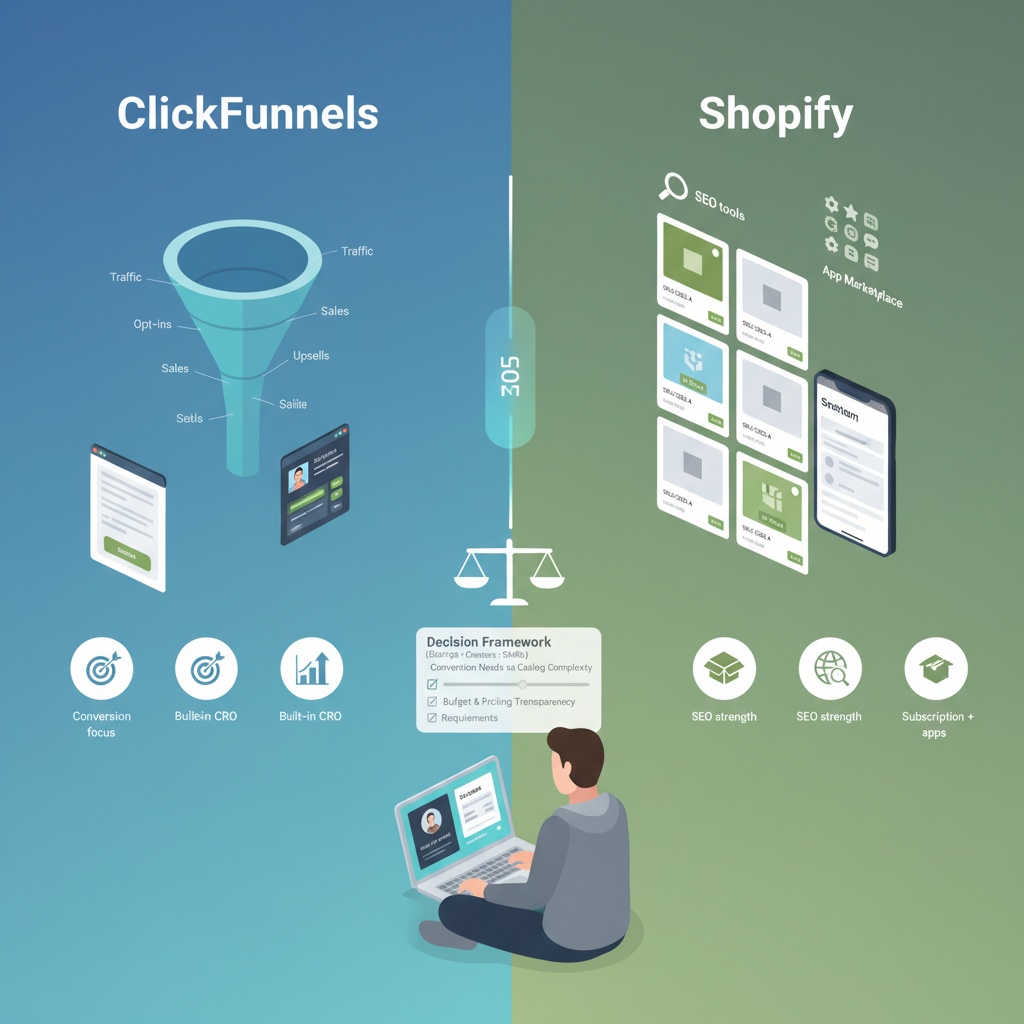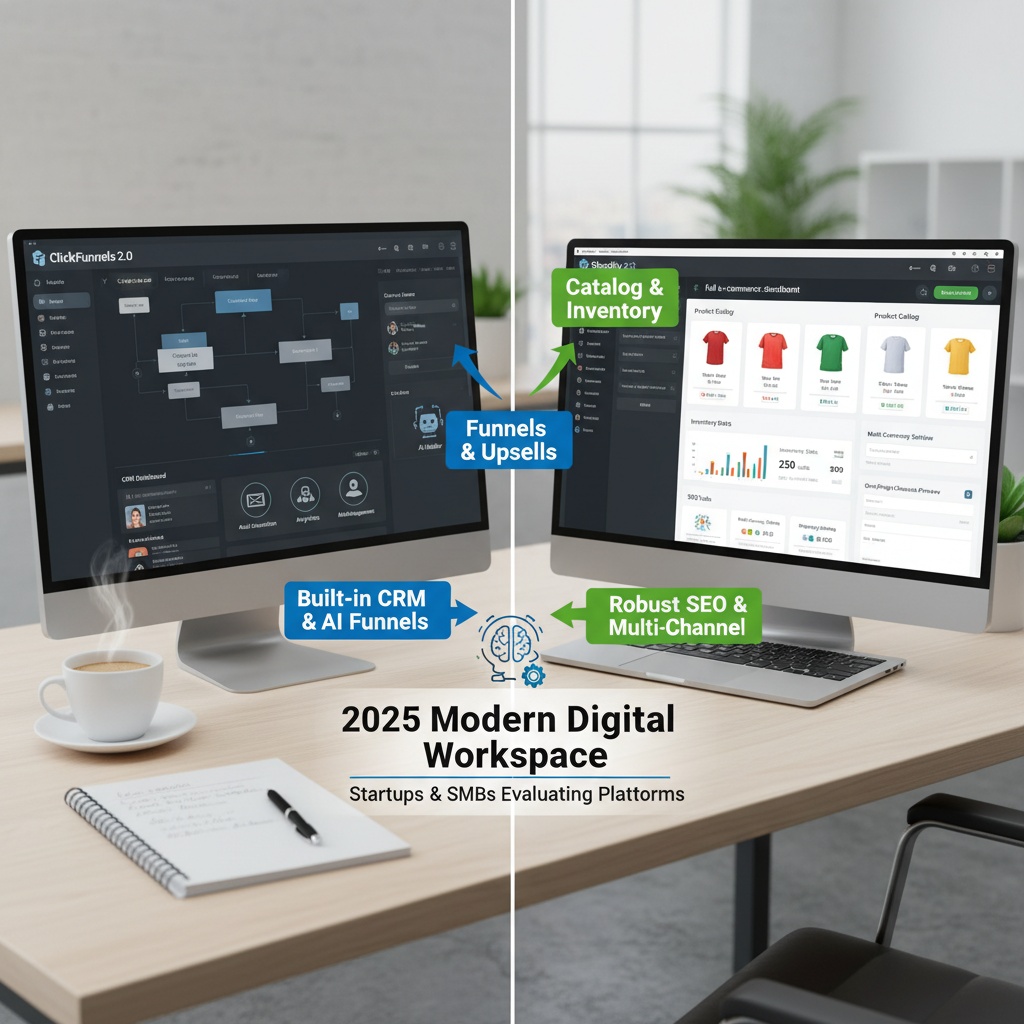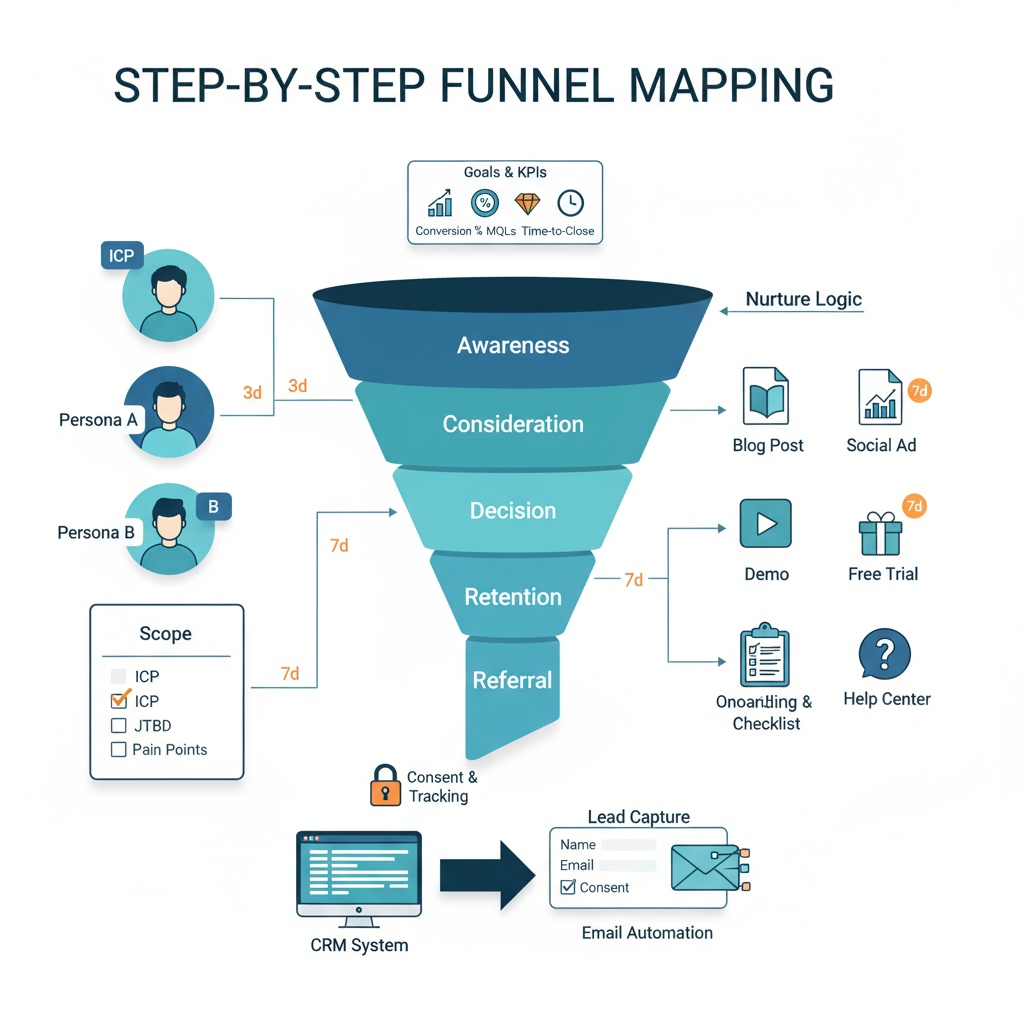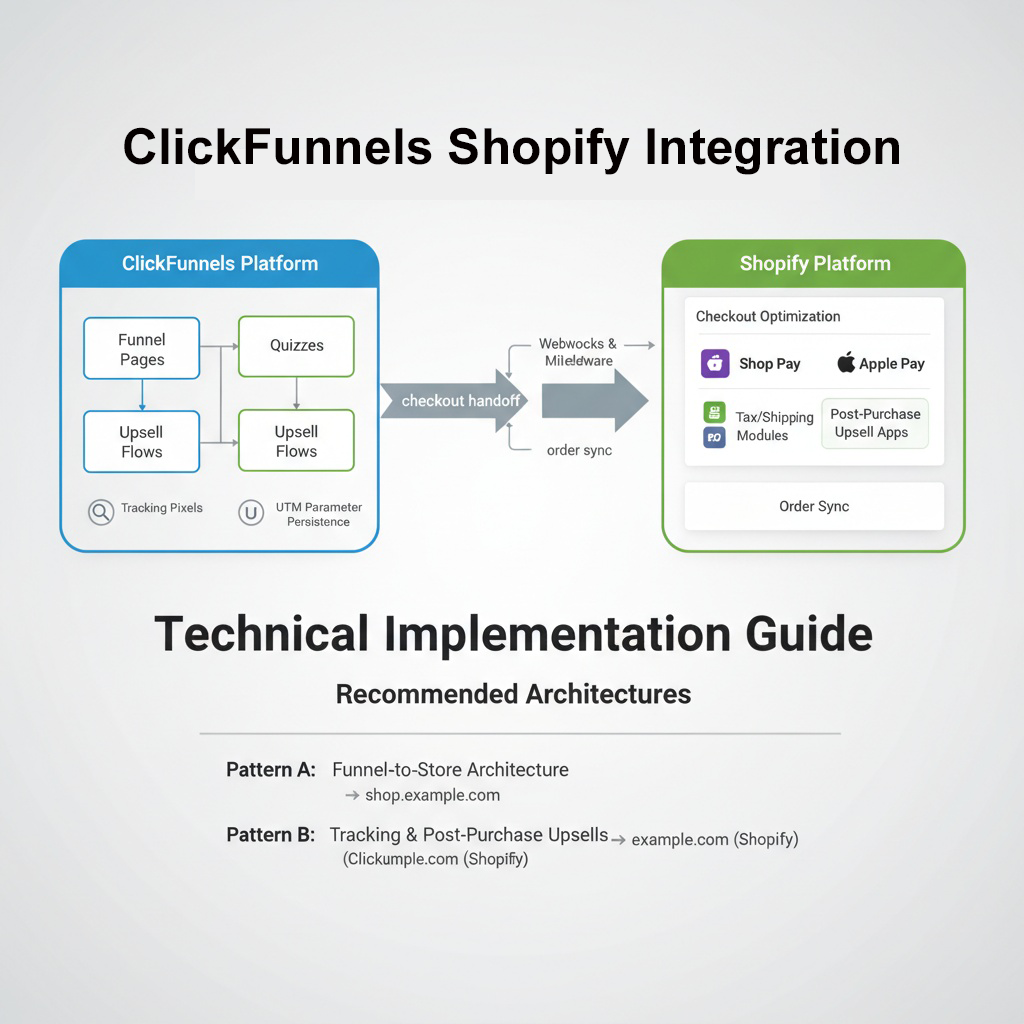Clickfunnels vs Shopify in 2025: Funnels vs Storefronts—Pricing, SEO, Integrations, and a Neutral Decision Framework
Choosing the right platform hinges on one core trade-off: conversion-focused funnels versus a scalable e-commerce storefront. ClickFunnels 2.0 is built for speed-to-market launches, high-intent sequences, and maximizing conversion rate with upsells, order bumps, A/B tests, and built-in CRM/automation. Shopify (2025 Editions) excels at multi-product catalogs, robust SEO, internationalization, POS, and fulfillment at scale.
If you’re selling a single offer or a few SKUs, funnels can drive faster revenue per visitor and higher average order value. If you’re building a brand with deep inventory, content marketing, and long-term organic acquisition, a storefront boosts lifetime value with navigation, search, and content hubs.
At a glance
- Start with ClickFunnels: creators, coaches, info-products, webinars, high-ticket consults, launch campaigns needing CRO-first flows and funnel analytics.
- Start with Shopify: DTC brands, SMBs, B2B/wholesale, subscriptions, retail/POS—any operation needing variants, merchandising, returns, and SEO content.
- Combine both: Shopify for catalog and SEO; layer ClickFunnels for launches, lead gen, and high-converting upsell/cross-sell journeys.
What this guide covers
- Feature-by-feature comparison: funnels vs catalogs, checkout, upsells, CRM/email, testing, analytics, and app ecosystems.
- SEO workflows: blog architecture, URL control, sitemaps/schema, internal linking, Core Web Vitals.
- Pricing and TCO: plans, processing fees, app stacks, and hidden costs—plus a simple cost calculator approach.
- Integrations and data flow: payments, email/CRM, webinars, fulfillment, analytics, and automation (Zapier/Make, APIs, webhooks).
- Practical scenarios and stack playbooks: single-offer, multi-SKU retail, B2B, subscriptions, digital courses, and hybrid approaches.
- Decision framework and migration paths: when to switch, when to pair, and how to avoid lock-in.
Related comparisons you may be weighing
- Kajabi vs Clickfunnels
- Leadpages vs Clickfunnels
- Samcart vs Clickfunnels
With 2025 upgrades like Shopify’s one-page checkout and ClickFunnels 2.0’s AI-assisted funnel builder, the gap has narrowed—but the strategy remains: match product complexity, conversion tactics, SEO dependence, and total cost of ownership to the right stack before you build.
ClickFunnels vs Shopify in 2025: funnels and storefronts, clearly defined

Choosing between ClickFunnels and Shopify in 2025 starts with recognizing that these platforms solve different selling problems. ClickFunnels is built for linear, conversion-first journeys where a prospect follows a guided path to a single outcome with upsells along the way. Shopify is engineered for browsing, discovery, and scale across many SKUs with deep merchandising, operations, and SEO. That distinction is not semantic. It determines your stack, your cost curve, and how you drive traffic and revenue.
If your current goal is fast launch cycles, high-intent sequences, and measurable increases in average order value, a funnel framework is often the shortest path to signal. If you need robust catalog management, internationalization, and reliable organic acquisition, a storefront architecture tends to win on durability. The nuance comes from how your product mix, traffic sources, and fulfillment needs evolve, which is why many businesses layer both over time.
Why this distinction drives CR, AOV, and LTV
Funnels like ClickFunnels concentrate attention on the next best action, which raises conversion rate and supports AOV lifts through order bumps and one-click upsells. Storefronts like Shopify compound lifetime value by supporting repeat purchases, account history, and rich content that improves SEO-driven discoverability. In practice, teams often designate funnel pages for launches and ads while the main site compounds LTV via content hubs and catalog breadth, a pattern echoed in the cmsMinds analysis.
- Conversion rate levers: step-by-step flows, limited navigation, split testing on key steps
- AOV levers: pre and post-purchase upsells, bundles, limited-time offers
- LTV levers: onsite search, collections, content architecture, customer accounts, subscriptions
Platform snapshots: ClickFunnels 2.0 vs Shopify 2025 Editions
ClickFunnels 2.0 prioritizes funnel velocity. The visual builder, integrated checkout, and native upsells make it simple to ship campaigns quickly. You also get built-in CRM, email sequences, memberships, and affiliate management so you do not need a separate marketing ops spine for small teams. Where it is less flexible is inventory depth, multi-variant cataloging, and sophisticated fulfillment.
Shopify’s 2025 stack is optimized for retail complexity. Online Store 2.0 themes and the new one-page checkout provide a modern buying experience, while B2B, POS, Markets, and subscriptions extend reach across channels and geographies. Advanced analytics, app extensibility, and developer tooling like Hydrogen support teams that plan to scale.
Quick fit matrix for different seller types
| Seller profile | Start with | Why it fits now | When to combine both |
|---|---|---|---|
| Solo creator with 1–3 offers | ClickFunnels | Speed to launch, upsell-centric flows, CRM/email built in | Add Shopify when adding SKUs or pursuing SEO |
| DTC startup with 10–50 SKUs | Shopify | Catalog depth, content-led growth, fulfillment workflows | Layer ClickFunnels for launch funnels and lead gen |
| High-ticket services or coaching | ClickFunnels | Application funnels, scheduling, pipelines | Add Shopify if selling merch or recurring physical products |
| Established SMB with retail/wholesale | Shopify | B2B, POS, inventory, internationalization | Run ClickFunnels for targeted campaigns and bundles |
SEO realities in ClickFunnels vs Shopify
SEO capability differs sharply because of architecture, content features, and URL control. Shopify gives you full-featured blogging, structured data, and internal linking patterns that enable topical hubs. ClickFunnels offers fast-loading landing pages but less control for sitewide SEO scaling.
| SEO factor | ClickFunnels | Shopify |
|---|---|---|
| Blog architecture | Basic pages suitable for campaigns | Full blog engine, collections, archives, and sitemaps |
| URL control | More rigid structures | Flexible URLs, redirects, custom handles |
| Schema and meta | Limited structured data | Rich schema, meta fields, product structured data |
| Internal linking | Funnel-step linking mostly | Sitewide navigation, content hubs, collection nests |
| Performance at scale | Fast single pages | Optimized for Core Web Vitals at store scale |
Content strategy tip: place evergreen content and product education on Shopify, and reserve ClickFunnels for conversion-optimized offers and launch sequences.
Pricing and total cost of ownership framing
Direct plan costs are simple. Real TCO comes from email sends, apps, processing fees, internationalization, and the time you spend integrating tools.
ClickFunnels cost centers:
Monthly plans with contact or page view thresholds
Email sending, membership/course hosting, potential add-on analytics
Payment processing via Stripe or PayPal
Integrations through Zapier/Make if you extend beyond native features
Shopify cost centers:
Tiered plans from Basic to Advanced or Plus
App stack for upsells, SEO enhancements, reviews, fulfillment, subscriptions
Theme purchase or development hours
Processing fees, returns management, 3PL, potential app bloat
Simple TCO model to sanity check:
- Traffic x conversion rate x AOV x upsell take-rate
- Seats needed for CRM, support, and content ops
- Number of SKUs, variants, and markets that add app or workflow requirements
Illustrative ranges:
- Single-offer creator funnel: about 100 to 300 dollars per month all-in on ClickFunnels
- Growing SMB at 50 SKUs: Shopify plan at 79 to 299 dollars per month plus 100 to 500 dollars in apps, then processing fees
Use cases and practical scenarios you can copy
Single-offer or few-SKU digital products:
- Use ClickFunnels to run a webinar funnel, drive opt-ins, and apply one-click upsells
- Integrate native email to nurture sequences without a separate platform
High-ticket consultative services:
- Build application funnels and qualify leads with tags and scoring in ClickFunnels
- Sharpen your script and follow-up cadence using the techniques in our guide to remote high-ticket closing
Multi-product retail or apparel:
- Stand up a Shopify catalog with variants, size guides, and reviews
- Use Markets for cross-border pricing and localized content
Hybrid launches:
- Keep your main Shopify store for SEO and operations
- Spin up ClickFunnels for time-boxed launch pages, list building, and post-purchase flows
Integrations and data flow essentials
You need reliable handoffs between landing pages, checkout, fulfillment, and analytics. Plan your triggers and data models before you build.
Payments:
- Stripe and PayPal are common to both
- Shopify Payments unlocks multi-currency and fraud tooling on Shopify
Email and CRM:
- ClickFunnels includes CRM and broadcast tools
- Shopify pairs well with Klaviyo, Mailchimp, or HubSpot for deeper marketing automation
Fulfillment:
- Shopify’s app ecosystem connects to major 3PLs, returns portals, and inventory systems
- ClickFunnels can pass orders to fulfillment via Zapier or webhooks for simpler setups
Analytics and attribution:
- UTM hygiene and pixel placement are non-negotiable in both
- Shopify supports server-side tagging and robust analytics apps for deeper attribution
Performance, conversion, and analytics levers to plan now
A/B testing:
- Test headlines, hero imagery, and offers at the funnel step level in ClickFunnels
- Use Shopify testing apps for PDP layouts, price anchoring, and merchandising blocks
Upsells and order bumps:
- Implement native pre and post-purchase upsells inside ClickFunnels funnels
- Add post-purchase apps on Shopify’s one-page checkout to capture quick lifts
Tracking and reliability:
- Establish a naming convention for UTMs and ensure source-consistent tagging
- Consider server-side tagging on Shopify to strengthen signal quality
How this compares to Kajabi, Leadpages, and SamCart
Kajabi vs ClickFunnels:
- Kajabi makes course delivery and membership communities straightforward
- ClickFunnels offers deeper funnel control for launches, upsells, and high-intent flows
Leadpages vs ClickFunnels:
- Leadpages is excellent for simple landing pages and lead capture
- ClickFunnels extends to full funnels with CRM and one-click upsells
SamCart vs ClickFunnels:
- SamCart focuses on checkout and solid upsells
- ClickFunnels layers a full funnel builder, CRM workflows, and broader campaign flexibility
This context is useful if your core product is a course or membership and you are weighing a content-first stack before a storefront.
Migration paths and stack evolution without chaos
Start with ClickFunnels, add Shopify:
- Triggered by SKU growth, SEO reliance, or international expansion
- Map product data, orders, and tags to ensure clean attribution during migration
- Start with Shopify, add ClickFunnels:
- Triggered by launch cadence, need for aggressive upsells, or webinar funnels
- Sync product IDs and pricing to keep taxes, shipping, and inventory consistent
Risks to manage:
- Data portability, app lock-in, and duplicate attribution
- Stagger rollouts and use sandbox environments for testing
Neutral decision framework checklist for ClickFunnels vs Shopify
- Product complexity: number of SKUs, variants, bundles, and inventory rules
- Traffic composition: how dependent are you on SEO vs paid campaigns
- Fulfillment and returns: 3PL integrations, SLAs, and POS or B2B requirements
- Internationalization: languages, currencies, and localized content
- Conversion tactics needed: order bumps, one-click upsells, split tests, scarcity blocks
- CRM and email depth: native simplicity vs advanced segmentation and lifecycle automation
- Budget and TCO thresholds: plan, apps, email sends, processing fees, and dev time
- Launch timeline: speed to market vs custom control and orchestration
- Compliance and accessibility: PCI, GDPR, CCPA, and ADA priorities
With your baseline mapped, you are ready to stress test each platform against your metrics and constraints. In Part 2, we will translate this framework into a feature-by-feature analysis and a concrete TCO view, including how upsell mechanics, SEO configurations, and app choices shift your numbers.
Implementation Blueprints: Standing Up a Hybrid Stack That Converts and Scales
Treat ClickFunnels as the conversion layer and Shopify as the commerce backbone, but do not wire them loosely. Architect for clean attribution, synchronized catalogs, and unified profitability reporting from day one.
- System of record: pick Shopify as the product, inventory, and order source of truth if you sell physical goods at any meaningful volume. Use ClickFunnels for campaigns and front-end offers, then pass orders or leads downstream.
- Data integrity: establish canonical product IDs and variant SKUs in Shopify, then mirror those IDs in your funnel checkout to avoid reconciliation drift.
- Attribution: enforce strict UTM discipline and append campaign metadata to orders via hidden fields or webhooks. For privacy resilience, deploy server-side tagging on Shopify while keeping ClickFunnels pixels focused on upper funnel events.
Funnel-to-Store Data Flow That Avoids Analytics Blind Spots
You want granular visibility by campaign, not just channel. Build a two-way sync:
1) Lead capture and pre-sale
- ClickFunnels captures email and behavioral data in its native CRM. Immediately push contacts to your email platform or CDP with UTM stamps, consent flags, and funnel step metadata.
- For high-ticket pipelines, send webhook payloads into your CRM with call scheduling and sales stage fields. Pair these with the frameworks in our primer on remote high-ticket closing to coordinate consultative follow-up.
2) Checkout and orders
- If the funnel checkout processes the payment, sync the order to Shopify as a draft or completed order for inventory and fulfillment. Include product IDs, discounts, line item properties, campaign codes, and source medium.
- If checkout runs in Shopify, deep link from the funnel into prefilled carts or dynamic checkout links. Shopify Functions can insert post-purchase upsells that complement the funnel’s pre-checkout bumps.
3) Post-purchase lifecycle
- Map event flows like upsell accepted, refund processed, and subscription churn to both systems. Push these into analytics for true LTV by campaign and into email automation for tailored win-back journeys.
Lifecycle CRO: Match Tactics to Customer Intent
High-intent entry points deserve frictionless conversion. Broader discovery requires merchandising, trust assets, and content cadence.
- Launch and promos: ClickFunnels for direct response pages with order bumps and immediate scarcity mechanics. Mirror prices and SKUs from Shopify to avoid customer service conflicts.
- Evergreen storefront: Shopify merchandising with bundles, reviews, and search tuned for non-branded queries. Use intent clusters in navigation and collection copy to catch comparison shoppers.
- Post-purchase expansion: Implement one-click upsells in both environments, but avoid duplicating offers to the same buyer in a single session. Run suppression logic by cookie or email to prevent fatigue.
Industry Playbooks With Measurable Targets
Supplements and consumables
- Goal: subscription take rate above 25 percent on first order. Run a ClickFunnels pre-sale quiz funnel, then drop to a Shopify subscription checkout with preselected intervals. Track cohort reorder rate and prepay plan acceptance.
Beauty and cosmetics
- Goal: lift AOV via bundles without degrading margin. Promote a two-step funnel for limited drops, then push cross-sells on Shopify PDPs. Use UGC and shade finders for SEO pages.
B2B parts and supplies
- Goal: quote-to-close efficiency with account-based pricing. Capture applications in a funnel, then onboard to Shopify B2B catalogs with volume breaks and net terms. Attribute LTV to originating funnel even after purchase orders begin.
Digital courses plus merch
- Goal: reduce refund rate while raising cash collected. Run webinar or VSL funnels in ClickFunnels, deliver courses natively, then sell branded merch through Shopify. Align guarantee messaging across systems to avoid disputes.
SEO and Content Engine Without Cannibalization
You can run conversion pages in ClickFunnels without undermining organic growth, but respect how crawlers evaluate site architecture.
- Index strategy: keep short-lived promo funnels noindex, follow. Preserve crawl budget for Shopify blogs, collections, and evergreen landing pages that compound authority.
- Internal linking: link from high-authority Shopify posts to funnel opt-ins sparingly and with clear topical relevance. Most internal links should reinforce your collection and PDP hierarchy.
- Schema and snippets: use Shopify’s structured data for product, review, and FAQ objects. ClickFunnels can handle essential meta fields, but major schema should live on the store domain.
- Site speed: Shopify’s edge network supports Web Vitals at scale. Performance debt on funnel pages is acceptable during timed promotions, not as a default experience.
Checkout Engineering: Post-Purchase Offers Without Chaos
- Shopify one-page checkout with Functions
- Use post-purchase extensions for single-click add-ons that do not require re-authentication. Cap offers at one or two to protect CSAT and payment approval rates.
- ClickFunnels order bumps and downsells
- Deploy pre-checkout bumps for complementary accessories or warranty. Use downsells for payment-plan variants rather than discounting core value.
- Guardrails
- Prevent double fulfillment by locking same-SKU upsells already accepted upstream. Sync inventory in near real time to avoid overselling limited drops.
Financial Modeling: TCO, Margin, and Payback Windows
Model your stack on unit economics, not list pricing.
- Costs to include: platform tiers, app subscriptions, email sending, payment fees, theme or dev time, returns processing, fraud losses, and the hidden cost of analytics gaps.
- Margin simulation: run AOV x CR x upsell take rate scenarios with app fees and discount leakage.
- Payback targets: for paid acquisition, enforce a 30 to 60 day CAC payback window for physical goods and 0 to 14 days for info products. Funnel-first launches can accelerate cash collection, while storefront growth compounds through organic.
Risk and Compliance You Can Actually Operationalize
- Tax and invoicing: Shopify should calculate taxes and issue compliant invoices. If ClickFunnels collects payment, push the order into Shopify for proper tax records and returns workflow.
- PSD2 and SCA: keep strong customer authentication in mind when designing upsell flows. Shopify Payments handles edge cases more gracefully at scale.
- Accessibility: run audits on both environments. Shopify themes can be systematically improved, while funnel templates may require manual fixes for contrast and keyboard navigation.
Testing Roadmap: 30, 60, 90 Days
Days 1 to 30
- Launch a single-offer funnel with two creative angles. Track CR, AOV, bump uptake, and refund rate. Stand up server-side tagging and SKU parity.
Days 31 to 60
- Move evergreen traffic to Shopify PDPs and collections. Test bundling, review widgets, and a single post-purchase offer. Build one authority blog post per week around comparison or how-to topics.
Days 61 to 90
- Integrate attribution across ad platforms, ClickFunnels events, and Shopify orders. Begin cohorts by first-touch campaign and evaluate LTV curves. Decide which flows merit automation and which require manual optimization.
Tool Substitutions When ClickFunnels Is Not the Best Fit
Kajabi vs ClickFunnels
- If your priority is hosted courses with simple sales pages and community, Kajabi can replace the funnel layer with fewer parts. If you live on upsells and aggressive launch sequencing, ClickFunnels remains stronger.
Leadpages vs ClickFunnels
- Leadpages can cover basic landing pages and opt-ins for top-of-funnel growth. It will not replace a multi-step conversion engine with deep analytics or CRM-style follow-up.
SamCart vs ClickFunnels
- SamCart offers elegant checkout with solid one-click upsells. For complex pre-sell narratives, affiliate orchestration, and multi-step flows, ClickFunnels typically provides more control.
Pair any of these with Shopify when you need catalog depth, SEO, and fulfillment maturity.
Migration and Stack Evolution Without Revenue Dips
- Start funnel-first, shift SKU complexity to Shopify as your assortment grows. Port products with consistent IDs, replicate tax and shipping rules, and run parallel checkouts for one cycle before cutover.
- Start Shopify-first, add funnels for launches. Keep pricing parity, implement traffic splitting with UTMs, and hand off orders to one fulfillment source.
- De-risking: maintain a five-step rollback plan, including DNS, payment gateway toggles, and app deactivations. Keep logs of schema, theme, and Functions changes for instant reversion.
Conclusion
In the ClickFunnels vs Shopify decision, the evidence shows you’re choosing between a conversion engine and an operations backbone. Funnels deliver rapid time-to-revenue, disciplined paths, and aggressive AOV lifts; storefronts deliver catalog depth, fulfillment muscle, and SEO compounding for durable LTV.
Choose ClickFunnels when speed, one-path journeys, and native upsell logic are the growth lever. Choose Shopify when you need merchandising at scale, inventory control, internationalization, and content-led acquisition. When both realities exist, run Shopify as your primary store and layer ClickFunnels for launches, list building, and post-purchase offers.
Price the stack with TCO, not sticker tags: model traffic, target CR, AOV, upsell take rate, required apps, headcount, and fulfillment. Lean offer and simple operations favor a funnel-first start. Existing complexity, multi-SKU catalogs, and SEO reliance demand a Shopify-first build, extended with targeted funnels.
From a growth lens, funnels accelerate cash flow and analytics clarity; storefronts compound discoverability and retention. Pair them and you capture both—organic demand streams into conversion-optimized campaigns with clean attribution and higher lifetime value.
Adjacent choices resolve just as clearly: Kajabi vs ClickFunnels is basic course delivery versus advanced funnel architecture; Leadpages vs ClickFunnels is single-page capture versus end-to-end conversion flows; SamCart vs ClickFunnels is checkout-first versus full-funnel with CRM and automation. Shopify remains the e‑commerce operations spine across these comparisons.
Ultimately, commit to a starting stack now. Run the decision checklist, finalize your cost model, and deploy either a focused funnel or a production storefront this week. If your roadmap spans launches and scale, lock in the hybrid plan, use the TCO calculator, grab the starter stacks, and follow the implementation diagrams. Ship, measure, iterate—then expand with confidence.





